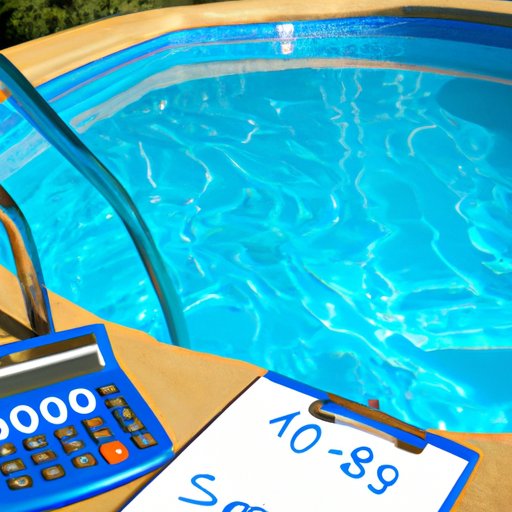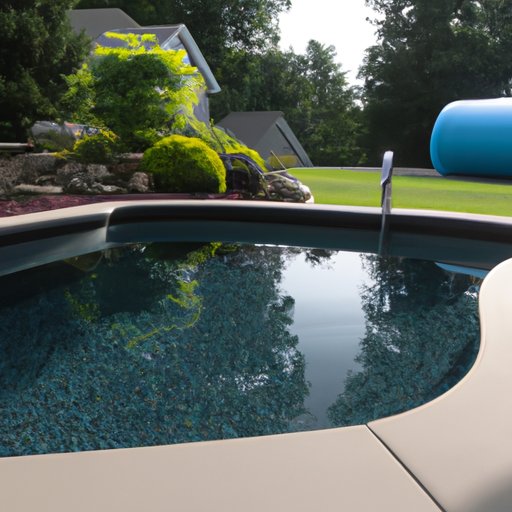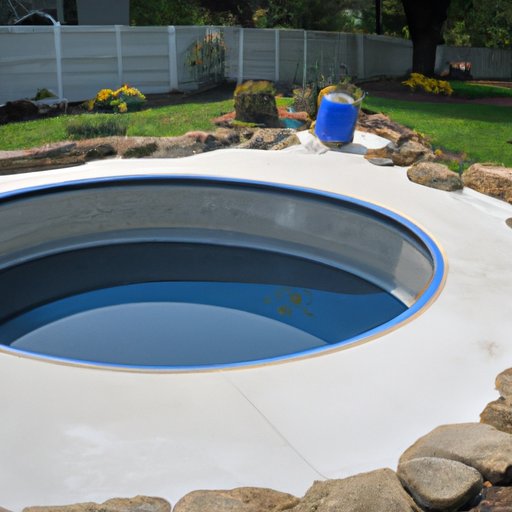Introduction
Having a swimming pool in your backyard can be a great way to enjoy the summer months with family and friends. But owning and maintaining an inground pool is more than just a fun pastime—it’s also a major investment. The cost of keeping your pool up and running will vary based on a number of factors, including the size and type of pool you own, the climate you live in, and the type of maintenance you choose to do. To help you understand the costs associated with owning an inground pool, we’ve put together this comprehensive guide.

Analyzing the Cost of Pool Maintenance: Breaking Down the Expenses for Inground Pools
The cost of maintaining an inground pool can be broken down into three main categories: monthly maintenance costs, yearly maintenance costs, and unexpected maintenance costs. Let’s take a closer look at each one.
Monthly Maintenance Costs
Monthly maintenance costs will depend on the type of pool you have (e.g., chlorine, saltwater, etc.), as well as the size of the pool. Generally speaking, however, you can expect to pay anywhere from $50 to $150 per month for basic maintenance. This includes items such as water testing, cleaning the skimmer and pump baskets, checking and adjusting chemical levels, and vacuuming the pool. If you have a saltwater pool, you may also need to add salt to the water every month.
Yearly Maintenance Costs
Yearly maintenance costs typically include items such as replacing the filter, draining and refilling the pool, and servicing the pool equipment. Depending on the size of the pool and the type of equipment you have, these costs can range anywhere from a few hundred dollars to thousands of dollars. Additionally, you may need to replace the pool liner or resurface the pool every few years, which can add to the overall cost of maintaining the pool.
Unexpected Maintenance Costs
In addition to the regular maintenance costs, there are also a number of unexpected costs that can arise when owning an inground pool. These can include things like repairing leaks, replacing pumps and filters, and dealing with algae or other contaminants. While it’s impossible to predict when these costs will arise, it’s important to plan for them in order to avoid any surprises.
How Much Does it Cost to Keep an Inground Pool Running?
When considering the cost of owning an inground pool, it’s important to remember that there are both start-up costs and ongoing costs. Let’s take a look at each one.
Overview of Start-up Costs
Before you can start using your inground pool, you’ll need to invest in a few key pieces of equipment. This can include items such as a pool cover, a pump and filter system, and a vacuum cleaner. Depending on the type and size of the pool, these costs can range anywhere from a few hundred dollars to thousands of dollars.
Ongoing Costs
Once the pool is up and running, there are a number of ongoing costs associated with maintaining it. These can include items such as monthly pool cleaning, chemical treatments, and repairs. Depending on the size of the pool, these costs can range from a few hundred dollars to several thousand dollars per year.

The Hidden Costs of Owning an Inground Pool: What You Need to Know About Maintaining Your Investment
In addition to the regular maintenance costs, there are a few hidden costs that come with owning an inground pool. Let’s take a closer look at some of these costs.
Repairs and Replacements
Over time, the various components of your pool, such as the pump and filter system, may need to be repaired or replaced. Depending on the complexity of the repair or replacement, these costs can range from a few hundred dollars to several thousand dollars.
Chemicals
Chemicals are an essential part of keeping your pool clean and safe. Depending on the type of pool you have, you may need to purchase chlorine, pH balancing chemicals, algaecides, and other products to keep your pool in top condition. These costs can add up over time, so it’s important to factor them into your overall budget.
Upkeep
Finally, it’s important to consider the cost of general upkeep. This can include items such as cleaning the pool deck, repairing tiles, and replacing worn out parts. Depending on the size of the pool and the amount of work needed, these costs can range from a few hundred dollars to several thousand dollars.
Making the Most of Your Inground Pool: A Comprehensive Guide to Pool Maintenance Expenses
Owning an inground pool is an investment, and it pays to do your research before committing to one. Here are a few tips to help you make the most of your pool and keep maintenance costs low.
Invest in Quality Equipment
When buying equipment for your pool, it pays to invest in quality. Cheaper products may seem like a good idea at first, but they often don’t last as long and require more frequent repairs. Investing in quality equipment upfront can save you money in the long run.
Consider Energy Efficiency
When choosing equipment for your pool, look for products that are energy efficient. These products use less electricity, which can help you save money on your monthly energy bill. Additionally, many energy efficient products qualify for rebates and tax credits, which can further reduce the cost of ownership.
Shop Around for Supplies
It pays to shop around for supplies. Prices can vary significantly between different stores and websites, so take the time to compare prices and find the best deal. Additionally, many stores offer discounts and coupons, so be sure to take advantage of them whenever possible.

Economically Maintaining an Inground Pool: Tips and Tricks to Keeping Costs Low
In addition to investing in quality equipment and shopping around for supplies, there are a few other tips and tricks you can use to keep the cost of maintaining your inground pool low. Here are a few of our favorites.
Utilize DIY Projects
For simple tasks, such as cleaning the skimmer and pump baskets, you can save money by doing the job yourself. With a little bit of research, you can easily learn how to maintain your pool and do the job yourself. This can be a great way to save money while still getting the job done right.
Reuse and Recycle
When replacing parts or disposing of chemicals, it pays to reuse and recycle whenever possible. Many pool supply stores will accept old pool equipment and chemicals for recycling, and some even offer discounts for doing so. Reusing and recycling can help you save money while also helping to reduce waste.
Take Advantage of Discounts
Many pool supply stores offer discounts and promotions throughout the year. Be sure to take advantage of these deals whenever possible, as they can help you save money on supplies and equipment. Additionally, many manufacturers offer warranties and extended service plans, which can be a great way to protect your investment and save money in the long run.
Get the Most Bang For Your Buck: How to Balance Quality and Cost When Maintaining an Inground Pool
When maintaining an inground pool, it’s important to balance quality and cost. Here are a few tips to help you get the most bang for your buck.
Prioritize Long-Term Value
When shopping for supplies and equipment, it’s important to prioritize long-term value. While it may be tempting to go for the cheapest option, it’s usually better to invest in quality products that will last longer and require fewer repairs. This can help you save money in the long run.
Research Different Options
It pays to do your research when shopping for supplies and equipment. Take the time to compare different options and find the one that offers the best value for your money. Additionally, reading customer reviews can be a great way to get an unbiased opinion about a product before making a purchase.
Don’t Sacrifice Quality
Finally, it’s important to remember that it’s not always wise to sacrifice quality for cost. Investing in quality products and services can help you save money in the long run, as they tend to require fewer repairs and last longer. So while it’s important to be mindful of your budget, it’s also important to make sure you’re not sacrificing quality.
All You Need to Know About Maintaining an Inground Pool: A Comprehensive Guide to Pool Maintenance Costs
Maintaining an inground pool is a significant investment, but it doesn’t have to break the bank. By understanding potential risks, planning for unexpected expenses and developing a maintenance schedule, you can ensure that your pool is taken care of without breaking your budget.
Understand Potential Risks
Before investing in an inground pool, it’s important to understand the potential risks associated with owning one. These can include things like leaky pipes, faulty equipment, and pool contamination. Understanding these risks ahead of time can help you prepare for any potential issues and minimize the cost of repairs.
Plan for Unexpected Expenses
It’s also important to plan for unexpected expenses. Things like repairs and replacements can pop up at any time, so it’s important to have a contingency fund set aside for these types of costs. Additionally, having a budget for emergency repairs can help you avoid any costly surprises.
Develop a Maintenance Schedule
Finally, it’s important to develop a regular maintenance schedule for your pool. This can include things like weekly cleaning, monthly inspections, and annual deep cleans. Having a regular maintenance schedule can help you keep your pool in top condition and prevent any costly problems down the line.
Conclusion
Maintaining an inground pool can be a significant investment, but it doesn’t have to break the bank. By understanding potential risks, planning for unexpected expenses, and developing a maintenance schedule, you can ensure that your pool is taken care of without breaking your budget. Investing in quality equipment, shopping around for supplies, and taking advantage of discounts are all great ways to keep costs low while still getting the most out of your pool.
(Note: Is this article not meeting your expectations? Do you have knowledge or insights to share? Unlock new opportunities and expand your reach by joining our authors team. Click Registration to join us and share your expertise with our readers.)
